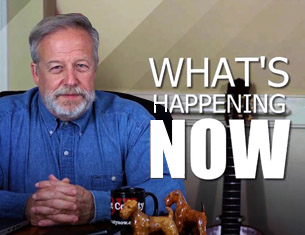Stewards of the Visual Exposition
Part IV - ANATOMY of a SUPREME COURT CASE: District of Columbia v. Heller (2008)
Thus, the American revolution started over our RIGHT to keep and bear arms. Tensions with Great Britain may have started over the right not to be taxed without representation in Parliament (the body from which such taxing measures arose), but the actual revolution itself erupted over the actions of the Crown to disarm the people.
So, the colonies won their independence, and the next step was to form a common government and our Bill of Rights. How did we get the language of our Second Amendment and what does it mean? First of all, our Founding Fathers borrowed liberally from the English Bill of Rights, including the right to Petition Government in the First Amendment, the right of Due Process in the Fifth Amendment, and the Right to Keep and Bear Arms in the Second Amendment. These were rights that they enjoyed and held dear as Englishmen and believed traveled with them to the New World.
Looking at the Constitutions and Bills of Right of our original 13 states, there were at least three colonial models to address the right to arms:
The Virginia Declaration of Rights read: "That a well-regulated militia, composed of the body of the people, trained to arms, is the proper, natural, and safe defense of a free state...."
The Pennsylvania Declaration of Rights read: "The people have a right to bear arms for the defense of themselves and the state."
The Massachusetts Bill of Rights read: "The people have a right to keep and to bear arms for the common defense."
We can see the two views of our Second Amendment embodied in these colonial Bills of Rights.
Fast-forward to the US Constitution and the ratification process whereby the states were debating whether to adopt it. New York ratified it, but only conditionally - conditioned on the addition of a Bill of Rights. Virginia narrowly ratified it, but those against its adoption, most notably Patrick Henry, held all the power in state government. They were going to call for another Constitutional Convention to alter Madison's Constitution, and they were going to appoint all anti-Federalists to the US Senate and draw up Congressional district maps to ensure all anti-Federalists were elected to the first US House. Madison, who wanted to be seated in that first government, would be shut out. The state legislature, with Henry wielding great power, had already denied him an appointment to the Senate (this was before the 17th amendment) Eventually, Madison made a compromise. If he were elected to the first US House, he promised to introduce a Bill of Rights for the States.
In fact, his state of Virginia had proposed a Bill of Rights for the new constitution, including a precursor to our Second Amendment, which included language from all three colonial models - Virginia, Pennsylvania, and Massachusetts.
On June 8, 1789, in the first US House, James Madison made true on his promise and he introduced a set of amendments to add a Bill of Rights to our Constitution. His Second Amendment read: "The right of the people to keep and bear arms shall not be infringed; a well-armed and well-regulated militia being the best security of a free country; but no person religiously scrupulous of bearing arms shall be compelled to render military service in person."
The first Congress shortened Madison's proposal so that it read: "A well-regulated Militia, being necessary to the security of a free State, the right of the people to keep and bear Arms, shall not be infringed."
The important thing to note in this historical review is that the Second Amendment is actually two separate thoughts. It was the conscious and intentional design of our Founders to express the right to arms in the broadest terms possible, to be understood in its broadest sense. [Diane Rufino, "The History of the Second Amendment Teaches Us its Meaning and Intent (Liberal Judges and Professors Do Not)"].
References:
Diane Rufino, "The History of the Second Amendment Teaches Us its Meaning and Intent (Liberal Judges and Professors Do Not)," January 14, 2019.
DVD: "In Search of the Second Amendment (A Documentary)," produced and directed by David T. Hardy (2006). Second Amendment Films LLC
Diane Rufino, "Making Sense of the Meaning and Intent of the Second Amendment: It's Not Difficult Folks!," May 23, 2017. Referenced at: https://forloveofgodandcountry.com/2017/05/25/making-sense-of-the-meaning-and-intent-of-the-second-amendment-its-not-hard-folks/
Adam Winkler, "Gun Fight: The Battle Over the Right to Bear Arms in America." 2011, W.W. Norton & Company, NYC.
Publisher's note: This ends the fourth part of this multi-part series by Diane Rufino examining District of Columbia v. Heller (2008). Part I, II, III and all succeeding parts of this mammoth treatise can be found here.
Go Back
So, the colonies won their independence, and the next step was to form a common government and our Bill of Rights. How did we get the language of our Second Amendment and what does it mean? First of all, our Founding Fathers borrowed liberally from the English Bill of Rights, including the right to Petition Government in the First Amendment, the right of Due Process in the Fifth Amendment, and the Right to Keep and Bear Arms in the Second Amendment. These were rights that they enjoyed and held dear as Englishmen and believed traveled with them to the New World.
Looking at the Constitutions and Bills of Right of our original 13 states, there were at least three colonial models to address the right to arms:
The Virginia Declaration of Rights read: "That a well-regulated militia, composed of the body of the people, trained to arms, is the proper, natural, and safe defense of a free state...."
The Pennsylvania Declaration of Rights read: "The people have a right to bear arms for the defense of themselves and the state."
The Massachusetts Bill of Rights read: "The people have a right to keep and to bear arms for the common defense."
We can see the two views of our Second Amendment embodied in these colonial Bills of Rights.
Fast-forward to the US Constitution and the ratification process whereby the states were debating whether to adopt it. New York ratified it, but only conditionally - conditioned on the addition of a Bill of Rights. Virginia narrowly ratified it, but those against its adoption, most notably Patrick Henry, held all the power in state government. They were going to call for another Constitutional Convention to alter Madison's Constitution, and they were going to appoint all anti-Federalists to the US Senate and draw up Congressional district maps to ensure all anti-Federalists were elected to the first US House. Madison, who wanted to be seated in that first government, would be shut out. The state legislature, with Henry wielding great power, had already denied him an appointment to the Senate (this was before the 17th amendment) Eventually, Madison made a compromise. If he were elected to the first US House, he promised to introduce a Bill of Rights for the States.
In fact, his state of Virginia had proposed a Bill of Rights for the new constitution, including a precursor to our Second Amendment, which included language from all three colonial models - Virginia, Pennsylvania, and Massachusetts.
On June 8, 1789, in the first US House, James Madison made true on his promise and he introduced a set of amendments to add a Bill of Rights to our Constitution. His Second Amendment read: "The right of the people to keep and bear arms shall not be infringed; a well-armed and well-regulated militia being the best security of a free country; but no person religiously scrupulous of bearing arms shall be compelled to render military service in person."
The first Congress shortened Madison's proposal so that it read: "A well-regulated Militia, being necessary to the security of a free State, the right of the people to keep and bear Arms, shall not be infringed."
The important thing to note in this historical review is that the Second Amendment is actually two separate thoughts. It was the conscious and intentional design of our Founders to express the right to arms in the broadest terms possible, to be understood in its broadest sense. [Diane Rufino, "The History of the Second Amendment Teaches Us its Meaning and Intent (Liberal Judges and Professors Do Not)"].
References:
Diane Rufino, "The History of the Second Amendment Teaches Us its Meaning and Intent (Liberal Judges and Professors Do Not)," January 14, 2019.
DVD: "In Search of the Second Amendment (A Documentary)," produced and directed by David T. Hardy (2006). Second Amendment Films LLC
Diane Rufino, "Making Sense of the Meaning and Intent of the Second Amendment: It's Not Difficult Folks!," May 23, 2017. Referenced at: https://forloveofgodandcountry.com/2017/05/25/making-sense-of-the-meaning-and-intent-of-the-second-amendment-its-not-hard-folks/
Adam Winkler, "Gun Fight: The Battle Over the Right to Bear Arms in America." 2011, W.W. Norton & Company, NYC.
Publisher's note: This ends the fourth part of this multi-part series by Diane Rufino examining District of Columbia v. Heller (2008). Part I, II, III and all succeeding parts of this mammoth treatise can be found here.






















